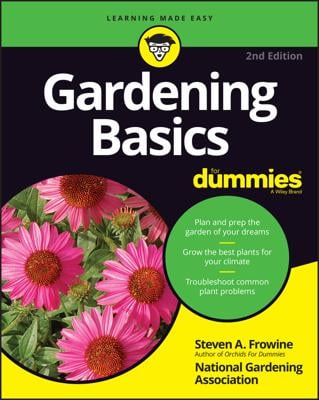Growing your garden requires the aid and cooperation of many forces including the climate in your hardiness zone; insects, good and bad; fertilizers; and soil amendments.
Decorative material (such as mulch, stone, sand, and gravel) adds a nice finish, so know how much you need to buy. Adapting each element to your garden's needs — as best you can — leads to a successful gardening experience.
Growing seasons by hardiness zone
Where you live has a lot to do with what you can grow in your garden and how you can grow it. You can use the following chart to determine the length and time of your growing season according to the USDA hardiness zone you’re in.
| Zone | Minimum Temperature (°F/°C) | Last Frost Date | First Frost Date | Typical # of Frost-Free Days |
|---|---|---|---|---|
| 1 | Below –50°F/Below –46°C | Jun 15 | Jul 15 | 30 |
| 2 | –50°F to –40°F/–46°C to –40°C |
May 15 | Aug 15 | 90 |
| 3 | –40°F to –30°F/–40°C to –34°C |
May 15 | Sep 15 | 120 |
| 4 | –30°F to –20°F/–34°C to –29°C |
May 10 | Sep 15 | 125 |
| 5 | –20°F to –10°F/–29°C to –23°C |
Apr 30 | Oct 15 | 165 |
| 6 | –10°F to 0°F/–23°C to –18°C |
Apr 15 | Oct 15 | 180 |
| 7 | 0°F to 10°F/–23°C to –12°C | Apr 15 | Oct 15 | 180 |
| 8 | 10°F to 20°F/–12°C to –7°C | Mar 10 | Nov 15 | 245 |
| 9 | 20°F to 30°F/–7°C to –1°C | Feb 15 | Dec 15 | 265 |
| 10 | 30°F to 40°F/–1°C to 4°C | Jan 20 | Dec 20 | 335 |
| 11 | 40°F and up/4°C and up | Frost-free | 365 |
Zone 1 is susceptible to frost all year.
Good insects for your outdoor plants
As a gardener, you know that although you wage war on some insects, you can enlist whole armies of beneficial insects to help your garden grow. You can buy the insects in the following list to help control pests that trouble your outdoor plants:
-
Lady beetles (or lady bugs): Both the adult and the lizard-like larvae are especially good at feeding on small insects, such as aphids and thrips. Release a few thousand of them in spring as soon as you notice the first aphid.
-
Green lacewings: Their voracious larvae feed on aphids, mites, thrips, and various insect eggs. Release them in your garden in late spring, after the danger of frost has passed.
-
Predatory mites: This type of mite feeds on spider mites and thrips. Add them to your garden in spring as soon as frost danger has passed.
-
Trichogramma wasps: Harmless to humans, these tiny wasps attack moth eggs and butterfly larvae (that is, caterpillars). Release trichogramma when temperatures are above 72°F (22°C).
Types of garden fertilizers
Before you buy fertilizer for your garden, be sure that you understand what’s available. The following list offers the common types of garden fertilizers and explains their components and uses:
-
Complete fertilizers: These contain all three macronutrients — nitrogen (N), phosphorous (P), and potassium (K).
-
Incomplete fertilizers: These are missing one or more of the macronutrients, usually the P or the K.
-
Chelated micronutrients: These are in a form that allows a plant to absorb them quicker than the more commonly available sulfated forms. If your plants just won’t green up (they stay mottled yellow and green, or just plain yellow), no matter how much nitrogen you apply, you probably have a micronutrient deficiency of iron, zinc, or manganese.
-
Foliar fertilizers: You apply these to a plant’s leaves rather than to its roots. You can use most liquid fertilizers as foliar fertilizers, but make sure that the label instructs you accordingly.
-
Organic fertilizers: These fertilizers derived their nutrients from something that was once alive. Examples include blood meal, fish emulsion, and manure.
-
Slow-release fertilizers: These provide nutrients to plants at specific rates under particular conditions. Some slow-release fertilizers can deliver the benefits of their nutrients for as long as eight months.
The amounts of gravel, sand, and mulch you need for your garden
Gravel, mulch, sand, small rocks, and soil amendments can play a healthy and decorative role in your garden. Gravel, sand, and rocks are generally sold by weight. For coverage that’s 2 inches (5 centimeters) deep, use the following amounts:
-
1 U.S. ton covers approximately 100 square feet.
-
1 metric ton covers approximately 10 square meters.
Soil amendments and mulch are generally sold by volume. For coverage that’s 2 inches (5 centimeters) deep, use the following amounts:
-
1 cubic yard covers approximately 160 square feet.
-
1 cubic meter covers approximately 20 square meters.
Use the following table to convert U.S. and metric measurements. In each case, the conversions are approximately equal:
| 1 centimeter ≈ 0.4 inches | 1 inch ≈ 2.5 centimeters |
| 1 meter ≈ 39 inches ≈ 1.1 yards | 1 yard ≈ 0.9 meter |
| 1 kilometer ≈ 0.6 mile | 1 mile ≈ 1.6 kilometers |
| 1 liter ≈ 1.1 quarts | 1 quart ≈ 0.9 liter |
| 1 kilogram ≈ 2.2 pounds | 1 pound ≈ 0.4 kilograms |
| 1 gram ≈ 0.04 ounce | 1 ounce ≈ 31 grams |

